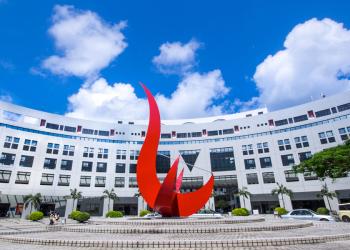HKUST Achieves the First Direct Observation of Homogeneous Crystal Melting at Single-particle Level
A research team led by Prof Yilong Han at the Department of Physics of the Hong Kong University of Science and Technology (HKUST) has for the first time successfully observed homogeneous melting at single-particle resolution, closing the long-term debate on alleged defects generated before melting. In addition to this, Prof Han and his team members Ziren Wang, Feng Wang, Yi Peng and Zhongyu Zheng also measured the superheat limit of colloidal crystals for the first time. All of these discoveries have been published in the latest issue of , one of the world's most prestigious scientific journals.
Crystal melting is a common phenemenon in nature, the conversion between ice and water being an everyday example. Notwithstanding the commonness, its microscopic mechanism remains poorly understood. The formation of liquid nucleus at the initial stage of phase change is crucial to the whole melting process, but its kinetics are difficult to measure because individual atoms or molecules are too small, moving too fast and difficult to observe in bulk. To explicate this phenomenon, micrometer-sized colloids have been used as 'big atoms' to simulate the more minutiae atomic systems because they demonstrate similar phase behaviors. For instance, colloidal particles can form crystals such as the gemstone opal. As such, researchers can directly observe colloidal particles' thermal motions under optical microscope and track their trajectories using image processing.
On the other hand, achieving homogeneous melting is another long-standing challenge facing the scientific community, because crystals always melt from surfaces or defects once they are heated to the melting point. If surface melting is surpressed in a perfect crystal, the crystal can be superheated above its melting point and this will lead to homogenous melting. Prof Yilong Han and his research group cleverly focused a beam of light into a high-quality colloidal crystal to achieve the superheated state and investigated homogeneous melting at single particle resolution for the first time. They observed that liquid nuclei are developed from strong vibrating regions associated with loop motions of particles. Particles swap their positions but preserve the crystalline structure, hence the melting precursors are not any type of defects predicted in past theories. The research team also measured for the first time a colloidal crystal can be superheated 20% above the melting point at most, a result similar to that of metals.
Prof Han said, "We conducted a series of comprehensive measurements on nucleation dynamics, which revealed deviations from the Classical Nucleation Theory. These discoveries deepen the understanding of microscopic processes in homogeneous nucleation and provide crucial experimental input to help guide any future refinement of theories for homogenous nucleation. In the meantime, our experimental system also provides a unique foundation to the study of solid-solid transitions and effects of a single defect or impurity on the melting transitions, which are of foundamental importance in materials physics."
Prof Yilong Han joined the Department of Physics at HKUST as an Assistant Professor in 2007. He obtained the bachelor degree from Peking University and doctoral degree from the University of Chicago, and did postdoctoral research at the University of Pennsylvania in the US.
For media enquiries, please feel free to contact :
Mavis Wong
Tel: 2358 6306
Email: maviswong@ust.hk









